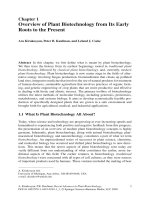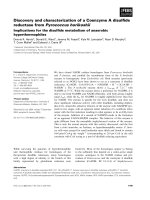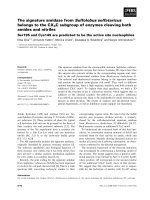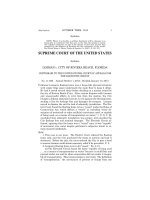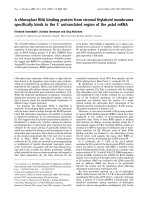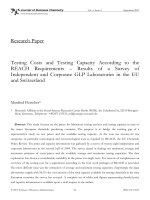- Trang chủ >>
- Khoa Học Tự Nhiên >>
- Vật lý
from marx and mao to the market the economics and politics of agricultural transition mar 2006
Bạn đang xem bản rút gọn của tài liệu. Xem và tải ngay bản đầy đủ của tài liệu tại đây (1.62 MB, 233 trang )
From Marx and Mao to the Market
This page intentionally left blank
From Marx and Mao
to the Market
The Economics and Politics of
Agricultural Transition
Johan F. M. Swinnen
Scott Rozelle
1
3
Great Clarendon Street, Oxford OX2 6DP
Oxford University Press is a department of the University of Oxford.
It furthers the University’s objective of excellence in research, scholarship,
and education by publishing worldwide in
Oxford New York
Auckland Cape Town Dar es Salaam Hong Kong Karachi
Kuala Lumpur Madrid Melbourne Mexico City Nairobi
New Delhi Shanghai Taipei Toronto
With offices in
Argentina Austria Brazil Chile Czech Republic France Greece
Guatemala Hungary Italy Japan Poland Portugal Singapore
South Korea Switzerland Thailand Turkey Ukraine Vietnam
Oxford is a registered trade mark of Oxford University Press
in the UK and in certain other countries
Published in the United States
by Oxford University Press Inc., New York
© J. F. M. Swinnen and S. Rozelle, 2006
The moral rights of the authors have been asserted
Database right Oxford University Press (maker)
First published 2006
All rights reserved. No part of this publication may be reproduced,
stored in a retrieval system, or transmitted, in any form or by any means,
without the prior permission in writing of Oxford University Press,
or as expressly permitted by law, or under terms agreed with the appropriate
reprographics rights organization. Enquiries concerning reproduction
outside the scope of the above should be sent to the Rights Department,
Oxford University Press, at the address above
You must not circulate this book in any other binding or cover
and you must impose the same condition on any acquirer
British Library Cataloguing in Publication Data
Data available
Library of Congress Cataloging in Publication Data
Data available
Typeset by Newgen Imaging Systems (P) Ltd., Chennai, India
Printed in Great Britain
on acid-free paper by
Biddles Ltd., King’s Lynn, Norfolk
ISBN 0–19–928891–7 978–0–19–928891–5
10987654321
v
Preface
This book is global in its coverage and its creation.
The study covers more than twenty-five countries, more than 300 million
hectares of land—a vast share of the world’s surface—and more than
1.5 billion people; including hundreds of millions of people who are living
or once lived in dire poverty. The book analyses, on one hand, arguably,
the most successful sets of policies in history that have lifted people out of
poverty, raising productivity and, in places, output by staggering amounts.
At the same time our research documents and measures dramatic failures
in policy processes and reforms that caused hunger and led to new poverty
where before there had not been any. In many cases, government measures
simply had a devastating effect on economic growth and development
for millions of other people.
The book has its roots in Ithaca, NY, where, as graduate students, we
shared adjacent offices in Cornell University’s Warren Hall. At the time,
neither of us could have imagined this would happen.
While Scott’s office was already stacked with thousands of survey forms
from China and a continuous flow of Chinese students and scholars, the
Berlin Wall was just coming down and Jo was still happily studying
the political economy of trade and agricultural policy. The most intense
interaction between the co-authors at the time were the jokes, stories,
and laughter coming through the wall; unfortunately for Jo, it was all in
incomprehensible Mandarin.
Only after returning to Europe, did Jo turn his attention to study the
transition process which had started in Central Europe and which was
spreading rapidly east—from Prague to Vladivostok. During his first years
back in Europe he was still writing on more traditional agricultural and
trade policies; but, soon, the study of transition in Central and Eastern
Europe irresistibly drew him to the East, into the field of comparative eco-
nomics and transition economies. Then he was captured by Brussels where
the issue of eastern enlargement of the European Union was increasingly
occupying the minds of policy makers in the European institutions.
During this time, Scott was building a parallel career with his research in
China, splitting his time between teaching and working with students in
Stanford and Davis, working with policy makers in Beijing, and travelling
through rural China. A large part of his time was spent in the field, collect-
ing data and observing first hand the reform miracle that was being played
out in East Asia.
As we realized later, both of us, with our respective research groups, had
spent a great deal of time and effort trying to understand the process of
transition in Asia and Europe by collecting original data and trying to con-
struct innovative indicators to measure the process of reform and its
effects. When possible, we tapped into existing sources of information.
Many times, however, the only option was to collect, enter, and analyse
our own survey data.
It was not until ten years later, in 1999, that we met up again, at an
annual meeting of the American Agricultural Economics Association
(AAEA) in Salt Lake City. On a mountain bike in the Rocky Mountains,
and later over a beer, we discovered that in fact our research interests and
discoveries were in many ways mirror images of one another. Slowly, it
dawned upon us that there were a tremendous number of synergies in
our work. By just exchanging ‘war stories’, we realized that there was so
much we could learn from comparing the transition processes in Europe
and Asia.
The first step was to swap papers. This led to an intensive exchange
of emails and phone calls. It was not long after that we were convinced
that a comparative study of the reform processes across the transition
world with such vastly different experiences as the so-called ‘Chinese
miracle’ and ‘Russian disaster’ was both needed and could yield truly
important insights. One of the most remarkable findings that became
clear to us during those first years was that such comparative analysis
and its lessons would be important not just for transition policies but
also for reforms and development strategies that went beyond former
Communist countries. This realization was followed by several small
steps that put us in public forums and let us begin to flesh out our ideas.
It led to a joint principal session at the following AAEA annual conference,
and to a plenary session at the International Association of Agricultural
Economists conference in Berlin in 2000. The process of integrating our
findings and insights had begun.
At some point during this process the idea of this book emerged. We
started jotting down our ideas on scraps of paper. The shreds of papers
begat printed outlines and the outlines begat a proposal. At first we
Preface
vi
thought it would be a simple compilation of our past work. But soon
we discovered that this would be unsatisfactory. The only effective way to
do it was to truly compare the processes—phase by phase; policy by policy;
from determinants to outcomes to political economy. We ended up going
far back into pre-reform history and pushing forward through the second
decade of reform and beyond. We went back to the drawing board more
times than we would like to remember. At times our project seemed lost
or stalled amidst that quagmire of other demands. But many of our
colleagues kept reminding us that we were on to something important.
This kept our spirits up through the numerous revisions.
The prospect of progress and fellowship—at venues spread all over the
globe—perhaps more than anything kept the work alive. Various ideas and
versions of the chapters were discussed and written in Davis, Leuven,
Beijing, Takoma Park, at the European Commission in Brussels and the
World Bank in Washington, DC. We met in hotel suites and coffee shops
in places like Berlin, Tampa, Denver, Durban, and between working ses-
sions we reflected on our progress on skis in the Sierra Nevada mountains
and on bike trails through the meadows of Whistler, and at the birthday
party of our friend Cis in Lubbeek. The final revisions were made—where
more appropriate?—in an establishment in Brussels where Karl Marx
worked on his Communist Manifesto.
Although our names appear as authors on this book, the insights in it
are based on more than a decade of research and collaborations with
many co-authors and students throughout the world. We owe thanks
to many people. Both of us have taken pleasure in collaborating and
discussing with many people in our studies on the issues covered in this
work, in many cases people from the countries which we studied. Our
gratitude goes to all of them. Unfortunately they are too numerous to
name completely.
A couple of people, however, deserve mention in particular. Above all,
we would like to thank Jikun Huang and Karen Macours for many discus-
sions and collaborations on related projects. Much of this work contains
their blood, sweat, and tears. Other colleagues we should thank include
Gejza Blaas, Richard Boisvert, Stefan Bojnec, Loren Brandt, Karen Brooks,
Allan Buckwell, Colin Carter, Pavel Ciaian, Csaba Csaki, Azeta Cungu,
Sophia Davidova, Alan deBrauw, Harry de Gorter, Klaus Deininger, Tomas
Doucha, Liesbeth Dries, Wally Falcon, Gershon Feder, Tibor Ferenczi,
Klaus Frohberg, Dinu Gavrilescu, Eva Germenji, Matthew Gorton, Hamish
Gow, Konrad Hagedorn, Jason Hartell, Ruifa Hu, Marvin Jackson,
Songqing Jin, Joep Konings, Andrzej Kwiecinski, Zvi Lerman, Guo Li, Bill
Preface
vii
Liefert, Bryan Lohmar, John McMillan, Olga Melyukhina, Gilles Mettetal,
Wolfgang Münch, Nivelin Noev, Albert Park, Scott Pearson, Jan Pokrivcak,
Ewa Rabinowicz, Marian Rizov, Gérard Roland, Mike Ryan, Alexander
Sarris, Andrea Segre, Eugenia Serova, Daniel Sumner, Stefan Tangermann,
J. Edward Taylor, Alexandra Trzeciak-Duval, Laura Tuck, Liesbet Vranken,
Jerzy Wilkin, Linxiu Zhang, and members of the OECD ad hoc expert
group on agricultural policies in non-member countries.
Members of the Centre for Chinese Agricultural Policy in Beijing, affili-
ates of the LICOS Centre for Transition Economics, and the Research
Group on Food Policy, Transition, and Development in Leuven have given
tremendous and invaluable help in assisting us with the data work in
this book. Anneleen Vandeplas did excellent editing work for the final
version of the manuscript.
Finally, we should thank Oxford University Press for being so patient
and persistent. And, of course, our families for supporting our work on this
book and our careers in so many different ways.
J. S.
S. R.
Preface
viii
Contents
List of Tables x
List of Figures xi
Abbreviations xiii
1. Introduction 1
Part I: The Economics of Agricultural Transition
2. Patterns of transition 13
3. A model of agricultural transition 28
4. Policy reforms 50
5. The effects of the reforms 76
Part II: The Political Economy of Agricultural Transition
6. Basic determinants of reform strategies 95
7. Why did the Communist Party reform in China,
but not in the Soviet Union? 100
8. Determining the pace of market liberalization 123
9. The political economy of property rights reform
and farm restructuring 134
Part III: Conclusions, Lessons, and New Developments
10. Conclusions 155
11. Lessons of agricultural transition 170
12. The second decade of transition 179
References 187
Index 203
ix
List of Tables
1.1. List and classification of transition countries 5
2.1. Growth of gross agricultural output (GAO) index in
transition countries 15
2.2. Growth of agricultural labour productivity (output per farm
worker, ALP) in transition countries 18
2.3. Growth of index of agricultural yields in transition countries 20
2.4. Growth of input use indices for agriculture in
transition countries 22
2.5. Annual growth rates of total factor productivity for
agriculture in various transition countries for selected years 24
3.1. Summary of effects of price liberalization and property
rights reforms on output, inputs, and average product of
farms in Socialist countries 37
3.2. Changes in price ratios, fertilizer use, grain output, and
average productivity in China, Russia, and the
Czech Republic during the initial five years of transition 47
4.1. Scope of property rights reform for agriculture in
transition countries 57
4.2. Restructuring of farming organization and
general reform indicators 59
5.1. Selected initial condition indicators for immediate
pre-reform period in transition countries 84
7.1. Conditions for agricultural reforms under Communism 101
x
List of Figures
2.1. Changes in gross agricultural output (GAO) index during
first 10 years of reform in transition countries 16
2.2. Changes in agricultural labour productivity (output
per farm worker, ALP) index during first 10 years of
reform in transition countries 17
2.3. Changes in agricultural labour use index during first
10 years in transition countries 19
2.4. Changes in agricultural yield index during first
10 years of reform in transition countries 21
3.1. Reforms, initial conditions, and production allocations
during transition 31
3.2. Reforms, initial conditions, and average productivity
during transition 36
3.3. Production allocations with strong production disruptions
and weak incentive effects 40
3.4. Production allocations with weak production disruptions
and strong incentive effects 41
3.5. Production allocations with market disruptions 43
3.6. Production allocations with a combination of various
reforms and disruptions 45
3.7. Output changes during transition with a combination
of reforms and disruptions 46
4.1. Change in agricultural terms of trade index (grain to
fertilizer price ratio) during first 10 years of reform in
transition countries 51
4.2. Share of agricultural land used by individual farms 58
4.3. Agriculture output by farm organization in Russia,
1989–2002 64
5.1. The impact of technology on the costs and benefits of
the shift to individual farming 82
xi
5.2. Pre-reform technology and the growth of individual farming 83
8.1. Political reforms and agricultural reforms in
Eastern Europe and the former Soviet Union 132
9.1. Schematic diagram of land reform choices in transition 135
List of Figures
xii
Abbreviations
ACC agricultural collective contract
AIC Agricultural Inputs Corporation
ALP agricultural labour productivity
APK agro-industrial complexes
CEE Central and Eastern Europe
CEECs Central and Eastern European countries
CIS Commonwealth of Independent States
CP Communist Party
EU European Union
FSU former Soviet Union
GAO gross agricultural output
HRS household responsibility system
TFP total factor productivity
TVE township and village enterprises
WTO World Trade Organization
xiii
This page intentionally left blank
1
1
Introduction
The emergence of China as a global economic powerhouse, the integration
of ten Central and Eastern European countries into the European Union
(EU), and the uncertain path of Russia towards a market economy have
occupied the minds and agendas of policy makers, business leaders, and
scholars throughout the world since the last part of the twentieth century.
Twenty years ago these developments were unimaginable. The extent and
the speed of the changes have taken everybody by surprise. The develop-
ments occurred so fast and the impact of the changes has been so vast that
the importance of understanding the forces that unleashed this process, the
importance of understanding how these changes became possible, and the
importance of understanding the lessons for other developing countries
cannot be overestimated. This is the overall goal of this book.
It all started in the Chinese countryside in the late 1970s. Until then, a
large share of the globe—from the centre of Europe to the south-east reaches
of Asia—was under Communist rule. The lives of more than 1.5 billion
people were directly controlled by Communist leaders. The lives of many
more were being affected by what was happening in the Communist bloc.
Changes emerged in the late 1970s and things have not been the same
since. In 1978 China embarked on its economic reform path by introducing
the household responsibility system (HRS) in agriculture. A few years later,
Vietnam followed. Both countries reduced price distortions and reallocated
key land rights from collective farms to rural households. The impact was
dramatic. Productivity and incomes in both countries soared (Lin 1992;
McMillan, Whalley, and Zhu 1989; Pingali and Xuan 1992). The reforms
lifted hundreds of millions of rural households out of dire poverty (World
Bank 2000). Economists praise the Chinese reforms as the ‘biggest anti-
poverty program the world has ever seen’ (McMillan 2002: 94) and have
claimed that the reform policies have led to ‘the greatest increase in eco-
nomic well-being within a 15-year period in all of history’ (Fischer 1994: 131).
As a consequence, expectations were high ten years later when leaders in
many nations of Central and Eastern Europe (CEE) and the former Soviet
Union (FSU) began to dismantle Socialism and liberalize their agricultural
economies. Reformers implemented a bold series of policies, increasing
incentives and modifying the institutions within which rural residents
lived and worked. The reforms, however, disappointed many nations. Farm
output fell and rural poverty increased (Brooks and Nash 2002).
The sharp differences among nations in the early impacts of agricultural
reform and transition in the rest of the economy triggered an intense debate
on the sources of growth (Dewatripont and Roland 1992, 1995; Murphy,
Shleifer, and Vishny 1992; McMillan and Naughton 1992; Sachs and Woo
1994; Roland 2000). Some researchers, especially those studying East Asia,
credit the gradual sequencing of reforms that initially focused mainly on
reforming property rights and delayed any major changes to the marketing
system (Perkins 1988). For example, Lin (1992), McMillan, Whalley, and
Zhu (1989), and Pingali and Xuan (1992) attribute most of the success of the
agricultural reforms in China and Vietnam to the rise in the incentives
provided by decollectivization. The case of China demonstrated that
transition in agriculture could succeed, at least in the early years, without
the disruption caused by the dismantling of government-run marketing
channels and in the absence of well-functioning markets (McMillan and
Naughton 1992; deBrauw, Huang, and Rozelle 2000, 2004).
In reaction to the claims about East Asia, sceptics responded that rural
development in China and Vietnam occurred primarily as a result of low
initial levels of development (Sachs and Woo 1994). Post-reform growth
was nothing more than the rise in economic activity that was experienced
elsewhere in East Asia during the post-Second World War era. Others have
been even more negative. Balcerowicz (1994: 34) writes that the use of
the ‘Chinese Way’ as an argument in favour of gradual reforms in CEE and
the Commonwealth of Independent States (CIS) is ‘a patent misuse of the
facts’. Hughes (1994: 135–6) states that ‘China’s path is in no way relevant
to the structural problems faced in Eastern Europe and the FSU’ and should
be ‘no guide to what can or should happen’.
As the reforms in CEE and the CIS have unfolded, differences in economic
performance among transition nations outside East Asia complicate the
puzzle. As we show in detail later in this book, although agricultural output
fell uniformly across Europe in the wake of the reforms, based on other
measures, within a short period of time the farming sectors in Hungary, the
Czech Republic, Slovakia, and other nations responded positively. Output
per unit of labour rose sharply. Total factor productivity (TFP) in agriculture
Introduction
2
grew as strongly in CEE within a few years after the fall of the Berlin Wall as it
did at a similar point in the reform process of China and Vietnam ( Jin et al.
2002; Benjamin and Brandt 2001; Macours and Swinnen 2000a).
Agriculture, however, did not fare as well in most CIS countries. Although
many policies—especially price adjustments and subsidy removals—were
common across CEE and the CIS nations, others, such as farm restructuring
and the liberalization of marketing institutions, proceeded more gradually
in most CIS nations. A careful examination of the subsequent outcomes
suggests that the nature of reform matters. While the magnitude of the
collapse in terms of output was no worse in the CIS nations than in CEE, when
measured in terms of productivity, the go-slow strategy in the CIS nations
faltered. Productivity in Russia, Ukraine, and Kazakhstan not only fell
sharply during the immediate post-reform period, it continued falling or
remained stagnant during most of the first decade of transition. Examined
through the lens of productivity, the patterns of performance are more
similar between East Asia and CEE than they are between CEE and the CIS
nations.
1.1. Measuring success and identifying its determinants
Given these intriguing combinations of policies and performances that have
unfolded during the first decade of transition in the agricultural sectors of
the world’s transition nations, we believe a renewed enquiry into the debate
about the choice of the reforms and their impact on economic performance
is due. The commonalities and differences of the nature of reform among
East Asian, CEE, and the CIS nations and the subsequent productivity
contours call for a careful comparative analysis. To do so, we turn to the
literature, draw on our own work from over the years, and build an empirical
picture of the policies and institutional shifts that triggered agricultural
growth in some of the world’s twenty-eight transition nations and led to
stagnation in others. The lessons learned from the process of transition in
the agrarian development of most of the formerly Socialist countries can
inform policy makers and scholars about the choice of reform strategy, the
constraints in making these choices, and the relationship between reform
and economic growth.
Focusing on agriculture to analyse which policies contribute to success and
failure of economic reform has several benefits. The sharpness of the policy
changes in agriculture and the fundamental differences among countries
provide as clean a test as we can get. The relative simplicity of agricultural
Introduction
3
relationships—a farm is an easier production entity to analyse than an
industrial firm—also adds clarity to the analysis. Hence, far from being a
limitation of the study, our analysis of the reforms of price policy, property
rights, and market liberalization in agriculture will yield important general
lessons for those interested in the more fundamental relationships between
reform, institutional change, and growth.
A book centring on agriculture also is inherently interesting, especially
to those studying economic development. For example, in most East
and Central Asian nations agriculture dominated the economy during
transition and the changes in the sector have had an important impact on
overall economic performance (Perkins 1994; Chan, Kerkvliet, and Unger
1999; Green and Vokes 1998). When more than 50 per cent of a nation’s
labour force is employed in agriculture, and when the major share of
consumer income is spent on food, successful agricultural reform can have
a major impact on poverty reduction and the welfare of the population. In
fact, in studying the link between policy and performance, we believe that
there are lessons for those studying economic performance outside the
transition world.
Although we will provide a lot of data, include a lot of analysis, and review
many studies, our work in this book is still best classified as a mega-analysis.
Despite some variation from study to study, we believe that one of the most
remarkable conclusions of our work in this book is that there is a fairly clear
and consistent set of findings.
To meet this goal, in the first part of our book we pursue several
specific objectives in analysing the economics of agricultural transition. In
Chapter 2, we systematically document the post-reform trends in the
agricultural performance in all transition countries of Asia and Europe.
A list of the twenty-eight transition countries that we examine (some in
more depth than others) by their geographical categorizations is in Table 1.1.
In Chapter 3, we present a conceptual model to help clarify some of the
essential characteristics of agricultural transition. In Chapter 4, we discuss
in detail several key reforms, such as price and subsidy changes, property
rights reform, and market liberalization. In Chapter 5, we review the
evidence linking these reforms to the observed rises and falls in output and
productivity and present quantitative assessments of the reforms’ effects. In
Chapters 10 and 11 of the book, we review our general findings and draw a
series of lessons.
While the transition literature is rich and we document, analyse, and
discuss many issues, we believe studying agriculture reform and perfor-
mance leads to several new sets of insights. First, unlike the view of sceptics
Introduction
4
who find little in common among reform experiences across the transition
world, the literature and data from East Asia, Central Europe, and the CIS
nations provide a consistent picture linking reforms in agriculture to the
performance of the sector. In particular, the miraculous growth of output
in East Asia and the crash in output in CEE and the CIS nations can almost
fully be explained by the shifts in the relative terms of trade. Second, while
the performances during the initial reform years differ dramatically in
terms of output contours between East Asia and CEE, when measured in
productivity, however, the paths are remarkably similar. Property rights
Introduction
5
Table 1.1 List and classification of transition countries
Regions Transition Central and Commonwealth Former
countries Eastern Europe of Independent Soviet Union
(CEE) States (CIS) (FSU)
East Asia China
Vietnam
Laos
Myanmar
Central Asia Mongolia
Kazakhstan x x
Kyrgyzstan x x
Tajikistan x x
Turkmenistan x x
Uzbekistan x x
Transcaucasus Armenia x x
Azerbaijan x x
Georgia x x
European CIS Belarus x x
Moldova x x
Russia
a
xx
Ukraine x x
Baltics Estonia x x
Latvia x x
Lithuania x x
Central Europe Czech Republic x
Hungary x
Poland x
Slovakia x
Balkans Albania x
Bulgaria x
Romania x
Slovenia x
a
Geographically, only part of Russia, including Moscow, is in Europe.
reform—decollectivization in East Asia and land restitution and farm
restructuring in some CEE nations—gave strong income and control rights
to producers which in turn resulted in strong productivity growth. The
emergence of institutions of exchange also played an important role in
explaining East Asian and CEE productivity growth. Finally, our analysis
demonstrates that the real outliers in the reform process are the CIS
nations. The absence of markets and poor property rights exacerbated the
deteriorating performance caused by falling output-to-input price ratios
and mired many CIS countries in a decade of productivity stagnation.
Based on these insights, several general lessons emerge. When measuring
success, it is important to carefully compare the performance of transition
nations on the basis of productivity, not output. Definition of success
changes fundamentally when comparisons are based on productivity. In
addition, while we find that initial conditions and the sequencing of policies
do make a difference in making reform policies successful, our analysis
suggests that above all success requires two key elements: good rights and an
institutional environment within which agents can exchange goods and
services and access inputs. However, despite the need for rights and markets
or market substitutes, we also find that there clearly is much room for
experimentation and heterogeneity. In the final analysis, on the basis of our
study of the first decade of agricultural transition we find that growth and
rising efficiency occurred in almost all nations in which reformers created
property rights and improved the marketing environment.
1.2. Choosing the reform path: a political economy analysis
While the findings in the first part of the book are important, the analysis
purposely ignores several fundamental questions: if price reform, property
rights reform and farm restructuring, and market liberalization raise
output and increase productivity, why is it that some nations still had
not implemented these policies even by the end of the first decade of
transition? If the policies as a set are most effective, why is it that some
nations implemented the policies gradually while others implemented
them all at once? And even more fundamentally, why is it that the policies
were implemented by the leaders of some Communist regimes while in
others it took a major regime shift for policies to gain momentum? In
other words, in the first part of the book, we implicitly assume that reform
policies are exogenous, determined by leaders by some unknown process
which was beyond the scope of the impact analysis. But, according to the
Introduction
6
political economy literature, the choices of policies are decisions that are
made by leaders who are seeking to optimize some complex objective
function. In making their decisions, leaders take action in an environment
constrained by economic, institutional, and social factors including the
behaviour of the agents whom they are trying to influence. Looked at in
this way, reform choices are choices endogenously made by leaders,
functions of series of material and behavioural constraints, not the least of
which is the enthusiasm of those at the grassroots, which in the case of the
agricultural reforms means the farmers and the local officials and farm
managers.
In the second part of the book, we explore the political economy of
agricultural reform policies in transition countries. There is a vast political
economy literature, both normative and positive.
1
Our approach in this
book is strongly empirical and positive. In other words, we try to explain
why certain policies have been chosen. We try to understand the objec-
tives, incentives, and constraints that have induced leaders in different
transition countries to choose the policy paths that they took. Such an
empirical approach distinguishes the analysis from many of the earlier
political economy papers on transition which have a strong normative
emphasis (for example Dewatripont and Roland 1992, 1995).
Second, we also base our analysis, as we do in the first part of the book, on
broad regional comparisons. We also focus the analysis on the reforms to
the agricultural sector. Our choice to study comparatively the agricultural
reforms is one of the primary ways in which the research in this book is
distinguished from other empirically based political economy studies of
reform (for example Fidrmuc 2000; Hellman 1998), or those limited to a
smaller region (for example Yang 1996; Wegren 1998).
Third, we take a longer time horizon than most political economy
studies. A large fraction of the book, as is common in much of the rest of
the literature, does centre its attention on the post-1989 transition world.
Our analysis, however, goes further. We believe it is also important and
instructive to study why the reforms did not occur earlier in either China
or the former Soviet Union, even though there were certain conditions
that made it appear the time was right for reform.
In putting together the political economy story of agricultural reform,
our analysis is conducted at two levels. First, we examine how the
differences in the political process of the agricultural reforms affected the
outcomes. To do so, we examine who supported the process of reform and
who resisted and show that it was in those nations where there was a
congruence of interests between the grassroots and the top leadership that
Introduction
7
agricultural reform could occur. In some sense, however, in linking politics
of the reform to the choice of reform strategy we are looking only at the
proximate causes. In much of the analysis, we go further, seeking to
uncover the fundamental determinants of not only the reform choices,
but also the reasons why the support of those at the grassroots differed
among nations.
Because the number of nations, the complexities of the policies, and the
timing of reforms differ so substantially, we must necessarily limit the scope
of our enquiry in this part of the book, too. As before we primarily restrict
our attention to a subset of policies: property rights reform and farm
restructuring and market liberalization.
2
In examining the determinants of
these reform policies we also limit ourselves to three broad questions. Why
was the Communist government in China able to guide the reform process
while it took a regime change in Russia (and in most of CEE and the other
CIS nations) to start the reforms? Why did the market liberalization and
other reforms happen so fast in some nations and happen only gradually in
others? Why did the nature of property rights reform in land and farm
restructuring differ so dramatically from nation to nation?
Even restricting the analysis in the second part of the book to address-
ing these three questions, however, is an ambitious task and needs to be
narrowed further. While there certainly are many reasons for the observed
differences among the choices that different leaders make, we focus on
four general categories of determinants: initial technology differences in
farming practices and the environment within which farming occurs;
differences in wealth and the structures of the economies; the ways the
different governments are organized—especially focusing on the degree
of decentralization; and the historical legacy of Socialism and the depen-
dency of certain reform measures on decisions that had been made during
the Communist era.
The second part of the book is organized as follows. Chapter 6 presents
several factors that we believe have had an important impact on leaders and
their choices of reform strategies. The chapter establishes a vocabulary,
defining what we mean by initial technology, the level of wealth, the
degree of decentralization, and other factors that may be affecting the
political economy of reform. The rest of the second part consists of four
sections that attempt to answer our four main questions. Chapter 7
analyses what caused the introduction of radical reforms of rights and farm
organization under the Communist regime in China, and why the
Communist leaders in the former Soviet Union did not introduce similar
reforms. Chapter 8 focuses on why China gradually implemented its
Introduction
8
market liberalization policies while, after the political changes in the early
1990s, nations in CEE and the CIS nations more or less simultaneously
introduced property rights reforms and farm restructuring and market
liberalization. Chapter 9 provides an explanation of the differences among
nations in their choice of land reform and farm restructuring strategies. In
this discussion we will examine several questions. Why did some countries
privatize land while others did not? What led some countries to practise
restitution? Why is it that some nations distributed land in kind to the
tiller, while others distributed land to groups of farmers as shares? Why
have some nations moved to individual family farming while others have
not? And, finally, what role have hard budget constraints played in making
countries such as Russia, Ukraine, and many of the Central Asian countries
so much slower in restructuring their farms than countries in Central
Europe?
The final part of the book presents the conclusions of the analyses in
both parts of the book, draws a series of lessons, and looks at more recent
and future developments. Chapter 10 presents the conclusions of Parts
I and II of the book and Chapter 11 discusses general lessons from our
analysis. In the final Chapter 12 we analyse recent developments in the
transition world—the second decade of transition—and how our analysis
is relevant for understanding the changes that took place during this
period.
Notes
1. Surveys of political economy studies applied to general economic issues are e.g.
Mueller (2003) and Persson and Tabellini (2000); surveys specific to agriculture
are e.g. de Gorter and Swinnen (2002), and specific to transition reforms e.g.
Roland (2002).
2. Since virtually all nations opted for price reform, there are few differences
among nations to study.
Introduction
9
This page intentionally left blank


